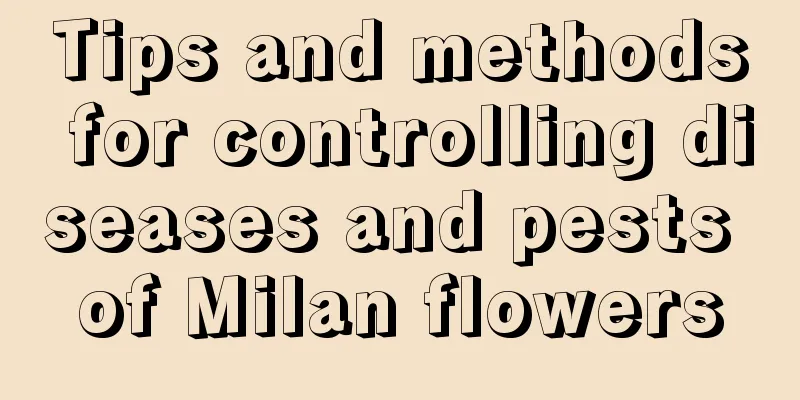Tips and methods for controlling diseases and pests of Milan flowers

|
Milan is also called Four-season Milan. Its leaves are round and small, the leaf color is emerald green, and the golden flowers look like strings of yellow millet , hence the name. When planting Milan flowers , improper management can easily lead to diseases and pests. Here are some tips and methods for controlling diseases and pests of Milan flowers. 1. Anthrax In the early stage of anthracnose, the leaf tips and edges turn brown and gradually spread to the leaves, with the edges of the spots becoming more obvious. When the petiole is first infected, the diseased part turns brown and spreads to the leaves. After the disease occurs, the leaves and petioles fall off until the branches are bare and dry up and die. Prevention and control techniques: In the initial stage, spray 70% thiophanate-methyl 800-1000 times diluted; 1% Bordeaux mixture; 80% anthracnose 400-800 times diluted; 50% captan 500 times diluted and other fungicides . 2. Scale insects Nymphs and adults gather on the back of leaves and branches to suck sap, causing the leaves and branches of Milan to turn yellow, the branches to wither, causing leaves to fall, and even the whole plant to die. Prevention and control tips: During the peak period of egg hatching, spray 1000 times diluted 25% phosmet emulsion; 1000 times diluted 50% malathion emulsion and other agents once every 10 days, and spray 2 to 3 times in a row. If the scale has already formed, 3-5 grams of 5% tifluanid and 10-15 grams of 3% fenvalerate can be buried in the flowerpot; or 1500 times diluted 40% cypermethrin emulsifiable concentrate can be sprayed. 3. Rust Milan leaves have small blisters on the lower or upper surface, containing yellow or rusty powdery spores. Prevention and control tips: In the early stage of the disease, spray 2000 times diluted 15% triadimefon wettable powder for prevention and control. 4. Sooty Disease Black water-like spots appear on the leaves, the spots spread, and the plants gradually wilt. Sooty disease is mostly caused by a hot and stuffy environment and poor ventilation. Prevention and control tips: Rinse leaves and branches with water, or spray with 1000 times diluted 70% methyl thiophanate. 5. Chlorosis Milan yellowing is more common. At the turn of spring and summer, when the temperature is high and there is a lot of rain, the lack of green in the new leaves is more obvious, which can not only cause the branches to wither, but in severe cases it can be fatal. Prevention tips: During hot summer weather, keep the room ventilated by opening windows or using fans to provide proper air circulation. That’s it |
<<: How to fertilize mint and what fertilizer to use
>>: How to fertilize lilac, what fertilizer is best
Recommend
What are the areas where walnuts can be grown?
Introduction to Wenwan Walnut Walnuts for ornamen...
This is the King of Summer. The hotter it gets, the taller it grows, and it becomes fat and plump like a spirit!
Purple Music Purple Music is also known as Purple...
What to do if Osmanthus fragrans leaves fall off
one. Growth habit In terms of growth habits, Osma...
How to propagate yellow rose
The propagation of Rosa lutea by division Rosa ru...
What medicinal materials are suitable for growing on loess soil? What are the most cost-effective precious medicinal materials grown on loess soil?
Medicinal herbs grown on loess soil should be sui...
Who is suitable to give baby's breath as a gift? Its meaning and flower language
1. Who should I give baby's breath as a gift?...
When is the right time to grow cucumber seedlings?
Cucumbers can be divided into two categories acco...
When and how to plant chili peppers
Pepper planting time The planting time of chili p...
What can't be eaten with lemon?
1. Seafood The rich calcium in seafood reacts wit...
How to grow hyacinth
1. Soil culture 1. Soil: Hyacinths can be grown u...
How to water roses in autumn
1. Watering method The temperature gradually decr...
How to deal with the blooming of threaded iron
Post-processing of threaded iron blooming The who...
The difference between egg fruit and passion fruit
1. Fruit Difference The fruit of the egg fruit is...
When does the desert rose bloom?
1. Which month does it bloom? This plant blooms t...
Basil cultivation methods and precautions
Pot soil selection Basil is a deep-rooted plant, ...









